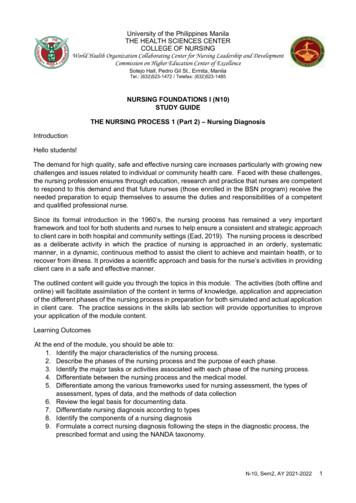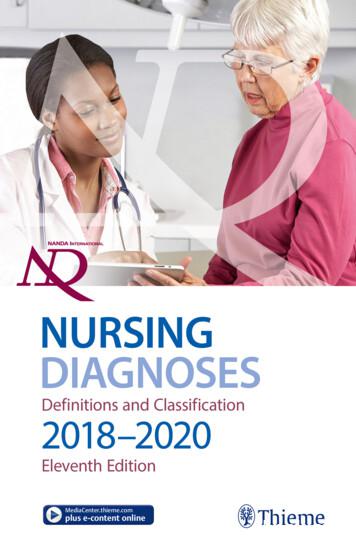NANDA-APPROVED NURSING DIAGNOSES
NANDA-APPROVED NURSING DIAGNOSES 2018-2020Grand Total: 244 DiagnosesAugust 2017Indicates new diagnosis for 2018-2020--17 totalIndicates revised diagnosis for 2018-2020--72 total(Retired Diagnoses at bottom of list—8 total)Credit line listed in the book:NANDA International, Inc. Nursing Diagnoses: Definitions and Classification 2018-2020, 11thEdition. Edited by T. Heather Herdman and Shigemi Kamitsuru. 2017 NANDA International, Inc. Published 2017 by Thieme Medical Publishers, Inc., NewYork. Companion website: www.thieme.com/nanda-i.1. Activity Intolerance (p. 228)2. Activity Intolerance, Risk for (p.229)3. Activity Planning, Ineffective (p. 322)4. Activity Planning, Risk for Ineffective (p. 323)5. Acute Substance Withdrawal Syndrome (p.351)6. Acute Substance Withdrawal Syndrome, Risk for (p. 352)7. Adaptive Capacity, Decreased Intracranial (p. 357)8. Adverse Reaction to Iodinated Contrast Media, Risk for (p. 429)9. Airway Clearance, Ineffective (p. 384)10. Allergy Reaction, Risk for (p. 430)11. Anxiety (pgs 324-325)12. Aspiration, Risk for (p. 385)13. Attachment, Risk for Impaired (p. 289)14. Autonomic Dysreflexia (pgs. 353-354)15. Autonomic Dysreflexia, Risk for (pgs 355-356)16. Bathing Self-Care Deficit (p. 243)17. Behavior, Disorganized Infant (pgs 359-360)18. Behavior, Readiness for Enhanced Organized Infant (p. 362)19. Behavior, Risk for Disorganized Infant (p. 361)
20. Bleeding, Risk for (p.386)21. Blood Pressure, Risk for Unstable (p.235)22. Blood Glucose Level, Risk for Unstable (p.177)23. Body Image, Disturbed (p. 276)24. Breastfeeding, Readiness for enhanced (p.162)25. Breastfeeding, Ineffective (p. 160)26. Breastfeeding, Interrupted (p. 161)27. Breast Milk Production, Insufficient (p. 159)28. Breathing Pattern, Ineffective (p. 230)29. Cardiac Output, Decreased (pgs 231-232)30. Cardiac Output, Risk for Decreased (p. 233)31. Childbearing Process, Ineffective (pgs 307-308)32. Childbearing Process, Readiness for Enhanced (p. 310)33. Childbearing Process, Risk for Ineffective (p. 309)34. Comfort, Impaired (pgs 442, 450, 452)35. Comfort, Readiness for Enhanced (pgs 443, 451, 453)36. Communication, Readiness for Enhanced (p. 262)37. Confusion, Acute (p. 254)38. Confusion, Chronic (p. 256)39. Confusion, Risk for Acute (p. 255)40. Constipation (p. 197-198)41. Constipation, Perceived (p.200)42. Constipation, Risk for (p. 199)43. Constipation, Chronic Functional (pgs. 201-202)44. Constipation, Risk for Chronic Functional (p. 203)45. Contamination (pgs 424-425)46. Contamination, Risk for (p. 426)47. Coping, Compromised Family (pgs 331-332)48. Coping, Defensive (p. 326)49. Coping, Disabled Family (p. 333)50. Coping, Ineffective (p. 327)
51. Coping, Ineffective Community (p. 329)52. Coping, Readiness for Enhanced (p. 328)53. Coping, Readiness for Enhanced Community (p. 330)54. Coping, Readiness for Enhanced Family (p. 334)55. Death Anxiety (p. 335)56. Decision-Making, Readiness for Enhanced (p. 366)57. Decisional Conflict (p. 367)58. Denial, Ineffective (p. 336)59. Dentition, Impaired (p. 387)60. Development, Risk for Delayed (p. 459)61. Diarrhea (p. 204)62. Disuse Syndrome, Risk for (p. 217)63. Diversional Activity Engagement, Decreased (p142)64. Dressing Self-Care Deficit (p. 244)65. Dry Eye, Risk for (p. 388)66. Dry Mouth, Risk for (p. 389)67. Eating Dynamics, Ineffective Adolescent (p.163)68. Eating Dynamics, Ineffective Child (pgs.164-165)69. Electrolyte Imbalance, Risk for (p. 182)70. Elimination, Impaired Urinary (p. 189)71. Emancipated Decision Making, Impaired (p. 368)72. Emancipated Decision Making, Readiness for Enhanced p. 370)73. Emancipated Decision Making, Risk for Impaired (p. 369)74. Emotional Control, Labile (p. 257)75. Energy Field, Imbalanced (p. 225)76. Falls, Risk for (pgs 390-391)77. Family Processes, Dysfunctional (pgs 290-292)78. Family Processes, Interrupted (p. 293)79. Family Processes, Readiness for Enhanced (p. 294)80. Fatigue (p. 226)81. Fear (pgs 337-338)
82. Feeding Dynamics, Ineffective Infant (pgs 166-167)83. Feeding Pattern, Ineffective Infant (p. 168)84. Feeding Self-Care Deficit (p. 245)85. Female Genital Mutilation, Risk for (p. 415)86. Fluid Volume, Deficient (p. 184)87. Fluid Volume, Excess (p. 186)88. Fluid Volume, Risk for Deficient (p. 185)89. Fluid Volume, Risk for Imbalanced (p. 183)90. Frail Elderly Syndrome (pgs. 145-146)91. Frail Elderly Syndrome, Risk for (p. 147)92. Gas Exchange, Impaired (p. 209)93. Gastrointestinal Motility, Dysfunctional (p. 205)94. Gastrointestinal Motility, Risk for Dysfunctional (p. 206)95. Grieving (p. 339)96. Grieving, Complicated (p. 340)97. Grieving, Risk for Complicated (p. 341)98. Health, Deficient Community (p.148)99. Health Behavior, Risk-Prone (p. 149)100. Health Literacy, Readiness for Enhanced (p. 143)101. Health Maintenance, Ineffective (p.150)102. Health Management, Ineffective (p.151)103. Health Management, Readiness for Enhanced (p.152)104. Health Management, Ineffective Family (p.153)105. Home Maintenance, Impaired (p. 242)106. Hope, Readiness for Enhanced (p. 267)107. Hopelessness (p. 266)108. Human Dignity, Risk for Compromised (p. 268)109. Hyperbilirubinemia, Neonatal (p. 178)110. Hyperbilirubinemia, Risk for Neonatal (p. 179)111. Hyperthermia (p. 434)112. Hypothermia (pgs 435-436)
113. Hypothermia, Risk for (p. 437)114. Immigration Transition, Risk for Complicated (p. 315)115. Impulse Control, Ineffective (p. 258)116. Incontinence, Bowel (p. 207)117. Incontinence, Functional Urinary (p. 190)118. Incontinence, Overflow Urinary (p. 191)119. Incontinence, Reflex Urinary (p. 192)120. Incontinence, Risk for Urge Urinary (p. 195)121. Incontinence, Stress Urinary (p. 193)122. Incontinence, Urge Urinary (p. 194)123. Infection, Risk for (p. 382)124. Injury, Risk for (p. 393)125. Injury, Risk for Corneal (p. 392)126. Injury, Risk for Thermal (p. 396)127. Injury, Risk for Urinary Tract (p. 394)128. Insomnia (p. 213)129. Knowledge, Deficient (p. 259)130. Knowledge, Readiness for Enhanced (p. 260)131. Latex Allergy Reaction (pgs 431-432)132. Latex Allergy Reaction, Risk for (p. 433)133. Lifestyle, Sedentary (p. 144)134. Liver Function, Risk for Impaired (p. 180)135. Loneliness, Risk for (p. 454)136. Maternal/Fetal Dyad, Risk for Disturbed (p. 311)137. Memory, Impaired (p. 261)138. Metabolic Imbalance Syndrome, Risk for (p.181)139. Mobility, Impaired Bed (p. 218)140. Mobility, Impaired Physical (p. 219)141. Mobility, Impaired Wheelchair (p. 220)142. Mood Regulation, Impaired (p. 342)143. Moral Distress (p. 371)
144. Nausea (p. 444)145. Neonatal Abstinance Syndrome (p. 358)146. Neurovascular Dysfunction, Risk for Peripheral (p. 400)147. Nutrition, Imbalanced: Less than Body Requirements (p. 157)148. Nutrition, Readiness for Enhanced (p.158)149. Obesity (p. 169)150. Occupational Injury, Risk for (p. 427)151. Oral Mucous Membrane Integrity, Impaired (pgs 397-398)152. Oral Mucous Membrane Integrity, Risk for Impaired (p. 399)153. Other-Directed Violence, Risk for (p. 416)154. Overweight (pgs 170-171)155. Overweight, Risk for (p. 172)156. Pain, Acute (p. 445)157. Pain, Chronic (pgs 446-447)158. Pain, Labor (p. 449)159. Pain Syndrome, Chronic (p. 448)160. Parenting, Impaired (pgs 283-285)161. Parenting, Readiness for Enhanced (p. 288)162. Parenting, Risk for Impaired (pgs 286-287)163. Perioperative Hypothermia, Risk for (p. 438)164. Perioperative Positioning Injury, Risk for (p. 395)165. Personal Identity, Disturbed (p. 269)166. Personal Identity, Risk for Disturbed (p.270)167. Physical Trauma, Risk for (pgs 401-402)168. Poisoning, Risk for (p. 428)169. Post-Trauma Syndrome (pgs 316-317)170. Post-Trauma Syndrome, Risk for (p. 318)171. Power, Readiness for Enhanced (p. 345)172. Powerlessness (p. 343)173. Powerlessness, Risk for (p. 344)174. Pressure Ulcer, Risk for (p. 404)
175. Protection, Ineffective (p. 154)176. Rape-Trauma Syndrome (p. 319)177. Relationship, Ineffective (p. 295)178. Relationship, Risk for Ineffective (p. 296)179. Relationship, Readiness for Enhanced (p. 297)180. Religiosity, Impaired (p. 372)181. Religiosity, Readiness for Enhanced (p. 374)182. Religiosity, Risk for Impaired (p. 373)183. Relocation Stress Syndrome (p. 320)184. Relocation Stress Syndrome, Risk for (p. 321)185. Resilience, Impaired (p. 346)186. Resilience, Readiness for Enhanced (p. 348)187. Resilience, Risk for Impaired (p. 347)188. Retention, Urinary (p. 196)189. Role Conflict, Parental (p. 298)190. Role Performance, Ineffective (pgs 299-300)191. Role Strain, Caregiver (pgs 278-280)192. Role Strain, Risk for Caregiver (pgs 281-282)193. Self-Care, Readiness for Enhanced (p. 247)194. Self-Concept, Readiness for Enhanced (p. 271)195. Self-Directed Violence, Risk For (p. 417)196. Self-Esteem, Chronic Low (p. 272)197. Self-Esteem, Risk for Chronic Low (p. 273)198. Self-Esteem, Situational Low (p. 274)199. Self-Esteem, Risk for Situational Low (p. 275)200. Self-Mutilation (pgs 418-419)201. Self-Mutilation, Risk for (pgs 420-421202. Self-Neglect (p. 248)203. Sexual Dysfunction (p. 305)204. Sexuality Pattern, Ineffective (p. 306)205. Shock, Risk for (p. 405)
206. Sitting, Impaired (p. 221)207. Skin Integrity, Impaired (p. 406)208. Skin Integrity, Risk for Impaired (p. 407)209. Sleep, Readiness for Enhanced (p. 215)210. Sleep Deprivation (p. 214)211. Sleep Pattern, Disturbed (p. 216)212. Social Interaction, Impaired (p. 301)213. Social Isolation (p. 455)214. Sorrow, Chronic (p. 349)215. Spiritual Distress (pgs 375-376)216. Spiritual Distress, Risk for (p. 377)217. Spiritual Well-Being, Readiness for Enhanced (p. 365)218. Spontaneous Ventilation, Impaired (p 234)219. Standing, Impaired (p. 222)220. Stress Overload (p. 350)221. Sudden Infant Death, Risk for (p. 408)222. Suffocation, Risk for (p. 409)223. Suicide, Risk for (pgs 422-423)224. Surgical Recovery, Delayed (p. 410)225. Surgical Recovery, Risk for Delayed (p. 411)226. Surgical Site Infection, Risk for (p. 383)227. Swallowing, Impaired (pgs 173-174)228. Thermoregulation, Ineffective (p. 439)229. Thermoreglation, Risk for Ineffective (p. 440)230. Tissue Integrity, Impaired (p. 412)231. Tissue Integrity, Risk for Impaired (p. 413)232. Tissue Perfusion, Ineffective Peripheral (p. 238)233. Tissue Perfusion, Risk for Decreased Cardiac (p. 236)234. Tissue Perfusion, Risk for Ineffective Cerebral (p. 237)235. Tissue Perfusion, Risk for Ineffective Peripheral (p. 239)236. Toileting Self- Care Deficit (p. 246)
237. Transfer Ability, Impaired (p. 223)238. Trauma, Risk for Vascular (p. 403)239. Unilateral Neglect (p. 251)240. Venous Thromboembolism,Risk for (p. 414)241. Ventilatory Weaning Response, Dysfunctional (pgs 240-241)242. Verbal Communication, Impaired (p. 263)243. Walking, Impaired (p. 224)244. Wandering (p. 227)
NANDA-APPROVED NURSING DIAGNOSES 2018-2020 Grand Total: 244 Diagnoses August 2017 Indicates new diagnosis for 2018-2020--17 total Indicates revised diagnosis for 2018-2020--72 total
with NANDA International were identifi ed, and nurs-ing diagnoses were determined using the diagnostic algorithm of NANDA. In the current nursing diagno-ses, defi ning characteristics and related factors were identifi ed based on the nursing diagnosis of NANDA International 2009-2011. In the case of possible nursing diagnoses, risk fac-
NANDA International (formerly the North American Nursing Diagnosis Association) sets the standards for nursing diagnoses with a taxonomy that incudes domains, classes, and diagnoses, based on functional health patterns. Nursing diagnoses are organized into different categories with over 400 possible nursing diagnoses: Moving (functional pattern):
Definition and purpose of nursing diagnosis (NANDA-I) North American Nursing Diagnosis Association Taxonomy (NANDA -I) organizing principles. The purpose of the NANDA International organization is to define, refine, and promote a taxonomy of nursing diagnostic terminology (Herdman, Kamitsuru, & North American Nursing Diagnosis Association, 2018).
The foci of the nursing diagnoses in NANDA-I Taxonomy II, and their associated diasgnoses, . Self-care 247 Self-concept 271 Self-directed violence 417 Self-esteem 272-275 Self-mutilation 418, 420 . 6.3 Data Analysis. 55 6.4 Identifying Potential Nursing .
Profile of nursing diagnoses in people with hypertension and diabetes. Invest. Educ. Enferm. 2017; 35(2): 139-153. DOI: 10.17533/udea.iee.v35n2a03 Profile of nursing diagnoses in people with hypertension and diabetes Objective. To identify the profile of nursing diagnoses in people with hypertension and diabetes in primary health care. Methods.
of Nursing Diagnoses of the North American Nursing Diagnosis Association (NANDA) and present possible nursing diagnoses and the management of symptoms according to these diagnoses. The Management of Symptoms in Polycythemia Vera . Evaluation. Nurses should obtain the detailed history of PV patients; carry out
North American Nursing Diagnosis Association (NANDA) NANDA didirikan sebagai badan formal untuk meningkatkan, mengkaji kembali dengan mengesahkan daftar terbaru dari diagnosis keperawatan yang digunakan oleh perawat praktisi. NANDA mengidentifikasi masalah atau k
Water Jet Machining & Abrasive Water Jet Machining Peiman Mosaddegh, Ph.D. Isfahan University of Technology Fall 2020. Peiman Mosaddegh –Non-traditional Machining Department of Mechanical Engineering راشفاب کیراب یارجم اب لزان زا یا هدش لرتنک هتسیپ ریسم زا شرب رازبا نانع هب بآ ،شر نیا رد دام هارمه هب بآ ای .























